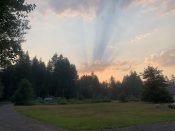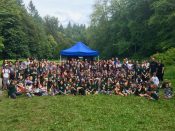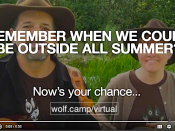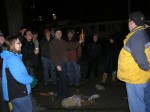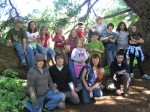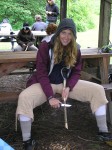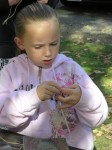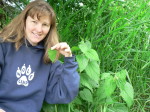We held our Wilderness Survival class at several locations this past month. The majority (if not all) of each class was spent outside which was an effective way to safely illustrate the importance of preparing oneself mentally for a survival situation. We started each evening by teaching everyone how to make strong rope out of raffia. Though one won’t find raffia growing in the Pacific Northwest (it’s from a palm tree!), it’s one of the easiest fibers to use when learning the reverse wrap process. Each class progressed differently based upon the location, timing and student’s interests but generally we followed the same outline.
Chris spent some time teaching the Critical Order of Survival and everyone practiced some simple breathing techniques. We talked about the importance of shelter, water and fire (and a metal pot!) and learned various ways to purify water (with and without modern conveniences such as a water filter or iodine tablets).
During the class co-sponsored by Seattle Backpackers, we had a brief navigation discussion and broke up into groups to do some basic map work. It was billed as a one-minute navigation training, but in effect, it was designed to train experienced hikers and backpackers how to quickly show friends and children how topographic lines work. Suffice it to say that it’s critical to use an area that includes familiar landmarks on it, which is easy to do nowadays with Google maps and selecting the “landscape” feature.
Then students learned a simple method for determining whether they are right or left dominant. This is especially important to know when hiking through underbrush and using a compass to navigate. We forgot to do this for the class co-sponsored by Kitsap Outdoors, but we promise to include it for them during our February class on Tracking Olympic Mountain Wildlife.
After the navigation exercise in Seattle, everyone was invited to taste water that had been purified that evening using iodine tablets. It wasn’t bad at all. It’s amazing how many people have carried around the tablets for years but have never tried them.
Next thing we did in Seattle was to give everyone a survival scenario to ponder, and then we broke into groups to discuss how we would respond. A spokesperson from each group shared the plan the team came up with.
We brought tall, dry grass, bags of leaves and bundles of sticks for making miniature shelters. Chris talked about the benefits of making a debris hut (nature’s sleeping bag) vs. a lean-to type shelter and when each would be most appropriate to build. Depending on the size of the group, everyone participated in building a single shelter or were split into two groups with each having 5 minutes to create their own shelter. Afterwards, Chris evaluated the shelters and offered tips for making them warmer, more secure and weatherproof.
Then it was time for everyone’s favorite – fire! Chris talked about various methods for creating a spark and how to catch that spark and blow it into flame. Everyone learned about different materials that could be used as tinder (such as cedar, cattail, jute and fireweed) and helped process them into a tinder bundle. Some of the students practiced the flint and steel method and Chris demonstrated both the hand-drill (typically used in the more dry regions of the country) and the bow-drill (our preferred method for this region).
After the show, we learned about some of the most important plants to know in order to survive in the wilderness. Cattail rhizomes are tasty after being cooked on the coals, stinging nettles are delicious cooked or raw (yep, really!) and pine, spruce and fir needles are high in vitamin C and make an excellent tea.
What a fun month focusing on Wilderness Survival! Next up for February: Tracking Animals Along the Pacific Northwest Trails


